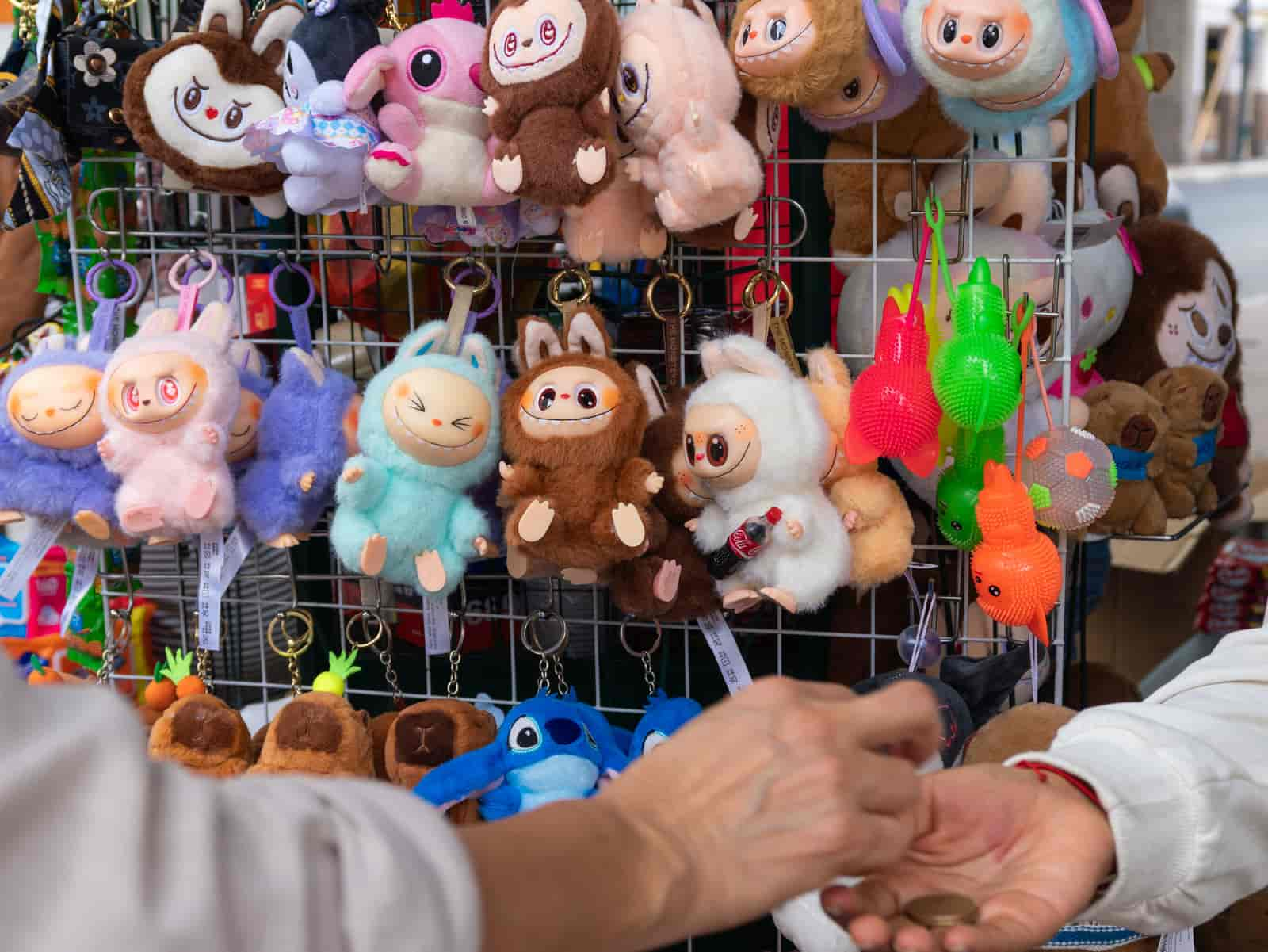Labubu are small, furry creatures with sharp teeth and a mischievous grin. They’re not cute, they’re not friendly – and yet they’ve become one of the hottest consumer trends in recent months. Created by Belgian artist Kasing Lung as part of his The Monsters series, they’ve been turned into a global phenomenon by the Chinese company Pop Mart. The formula is simple and powerful: each figure is sold in a sealed “blind box,” riding the wave of gamified consumption. Buyers hope to find the rarest variants, and completing a collection takes not just money, but also persistence.
This typical dynamic of the collectibles economy fuels a lively secondary market and, critics say, amounts to a soft version of gambling applied to everyday consumption. People discuss, trade, display, and share their finds on social media. In this way, Labubu have “hacked” the code of modern consumerism, becoming the ephemeral trophy of the moment (here without any negative connotation). Like most fads, they were first adopted by teenagers before spreading to adults eager not to miss out.
But what’s behind these odd-looking little monsters of questionable aesthetic taste and seemingly little practical use? Are they a new form of consumerism or proof – as cultural pessimists would claim – of moral and social decline? An economic phenomenon worth studying, or just a market failure? Fetish for the grotesque, for the commodity, or for the image itself? And above all: how did creatures born from the pencil of a Belgian illustrator travel to China, ship around the world on container vessels, and end up on the backpacks of kids, teenagers, and “Peter Pan” adults everywhere? In this article, we try to find out.
The monster factory
The monster invasion came from the East. Pop Mart is a Chinese company founded in 2010 in Beijing by Wang Ning (also known as Grant Wang). It began as a boutique for trendy gadgets and collectible figurines but over time invested in creating its own intellectual properties – such as Molly, Dimoo, Skullpanda and, more recently, The Monsters series featuring Labubu – often collaborating with independent designers.
The breakthrough came with the introduction of the blind box format. Each small box, sold at an affordable price (around €15 per piece), hides a figurine just a few centimetres tall. The buyer doesn’t know which one they’re getting, triggering repeat purchases to “complete the set” or hunt down rare “chase” figures – some of which can fetch hundreds of dollars on the secondary market.
The craze began in China around 2016–2017, when Pop Mart heavily pushed Molly, a doll with big eyes and a look somewhere between Japanese kawaii (meaning “cute” or “adorable”) and contemporary art. Molly’s viral success transformed Pop Mart from concept store into full-fledged Intellectual Property (IP) incubator: no longer just a retailer but a platform that discovers, produces and distributes designer toys. Essentially, Pop Mart sells collectible intellectual property, monetising it with events, fairs, physical shops, vending “roboshops,” licensing, and a thriving online marketplace. The real value lies in acquiring and scaling licences effectively.
The strategy worked: in December 2020 Pop Mart went public in Hong Kong with an initial market valuation of about $7 billion. On the first trading day, the share price more than doubled – proof of strong belief in its model.
Since then, Pop Mart has kept expanding, both in China and abroad, with physical stores, vending machines and a very active collector community that buys, trades and promotes products online. The Labubu mania has further boosted the company’s value: over the past year alone Pop Mart’s share price has surged 193%, pushing its market cap close to $75 billion.
The virality engine
Labubu’s story highlights a core trend in the consumer goods market that investors can’t ignore: product life cycles are getting shorter. New editions, fresh collaborations, endless variants – each object is born to be replaced quickly, driving compulsive buying. It’s the triumph of what French philosopher Jean Baudrillard called the simulacrum: what matters isn’t use, but meaning; not intrinsic value, but the social signal of owning and displaying.
This dynamic mirrors what powers digital content today. TikTok, for example, thrives on ultra-fast attention cycles: a trend goes viral and is replaced in days or weeks. Obsolescence is no longer tied to durability but to symbolic relevance. Pop Mart has industrialised this logic, acting almost like a content creator: every collection is new “content” to push; every collaboration is a bid to capture and renew public attention.
For the market, the ability to serialise virality is an asset. It’s not a single licence that matters but the machine capable of producing attention-grabbing series again and again. In this sense, Pop Mart is closer to a media brand than a toy maker – a factory of visual stories to collect and share. Of course, for investors, this remains risky: it relies on catching fleeting desires, reading ever-shorter attention spans and sustaining a pipeline of hits.
Value, passion and asymmetry
This doesn’t mean such items are destined for the dustbin of forgotten fads – the lively secondary market proves otherwise. In the collectibles economy, price is never fixed: it depends on how many people value a cultural symbol and how much they’re willing to pay. It’s an economy of belief, where nostalgia plays a crucial role.
It’s also an economy where insiders can profit. Knowledge of niche worlds – production runs, rare editions, hidden details – gives an edge over casual buyers.
The phenomenon isn’t new. Before Labubu there were Beanie Babies, Furby, Pokémon cards, Funko Pop. Some retained or increased their value, others didn’t. What’s new is the speed at which fads spread and fade, supercharged by social media. Online communities turn collecting into public performance. Whether Labubu will soon fade into collective oblivion or resurface decades later when Gen Alpha has disposable income is impossible to know. But holding onto a few might not be a bad idea.
Consumerism and small luxuries
Every craze has its critics. Some see it as a feverish symptom of social decline or proof of youth culture’s corruption. These arguments aren’t new, but Labubu mania does sit in a specific socio-economic context: today many young people struggle to afford a home, pay for university, or build long-term financial security.
That’s exactly why “small luxuries” are emerging – relatively affordable items that deliver instant gratification. It’s the lipstick effect applied to collectible toys: when big goals feel unattainable, symbolic pleasures fill the gap. No one is going bankrupt over Labubu, but the trend reflects the tension between frustrated aspirations and the desire to consume.
Still, while it’s fair to criticise consumerist excess, there’s no need for cultural doom. Every generation has had its collectible crazes – from porcelain dolls to stamps, comics to trading cards – each once derided as frivolous.
Ultimately, the “Labubu economy” shouldn’t be demonised or idealised. In a world where big life milestones feel distant for many young people, the answer isn’t asceticism. It’s learning to separate wants from priorities, and building a secure financial base. Collecting monsters can be an innocent, even ironic pleasure – but staying in control of your financial choices is the truly essential challenge.
*As with all investing, financial instruments involve inherent risks, including loss of capital, market fluctuations and liquidity risk. Past performance is no guarantee of future results. It is important to consider your risk tolerance and investment objectives before proceeding.





